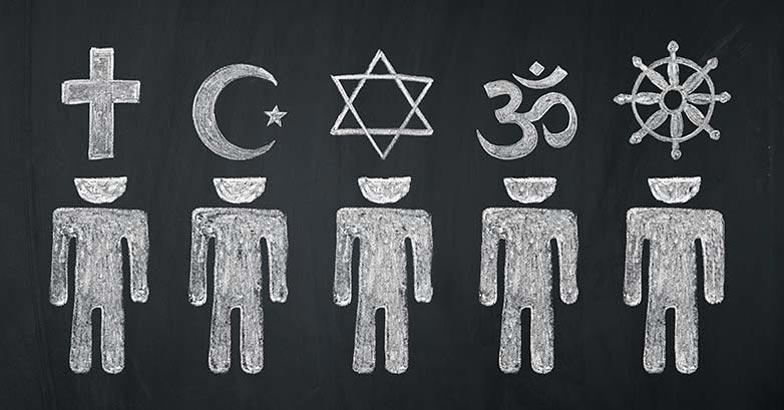
What Is The Term Secularism Mean?
There are so many complicated definitions but to put this term in simple words,
‘Secularism’ means separation from religion from any state affairs or we can also say that “NO RELIGIOUS BASE STATE.”
Origin Of The Word ‘Secularism’-
The word was first coined by George Jacob Holyoake in 1851. He invented the term to describe himself. He defined secularism as – “a code of duty pertaining to this life, founded on considerations purely human”.
He later explained that he found secularism is more positive than Atheism. By this term, he wanted to advocate the co-existence of the secular and religious elements, without rejecting religion.
History Of Secularism Of India
- It all started with the oldest scriptures of India:
The Vedas and The Upanishads,
“ekam sat viprabahudhavadanti”
- Which means one God is worshipped in different names.
“sarva dharma sambhava”
- It is a concept that shows the equality of destinations of the paths followed by all religions. In simple language, it translates as “all religions are the same”
- During the Mauryan period, the policy of dhamma was adopted. It means accepting people belonging to different communities.
- The Mauryan kings also adopted different dharma, Chandragupta took Jainism in his later years, Bindusara was in favor of Ajivika and Ashoka.
- He adopted Buddhism in his personal life. Though he never imposed Buddhism on his subjects.
- Bherigosha (conquest by force) was replaced by Dhammaghosha (conquest by dhamma).
The Sufi and Bhakti movements, it is popularized during the seventh to the sixteenth centuries. Both movements emphasized universal brotherhood and love and respect created for different sections of society.
There were some leading Sufi saints like Khwaja Moin-ud-din Chisti, Farid-Ud-din Ganj -i- Shakar popularly known as Baba Farid, Nizam-ud-din Auliya. And some famous bhakti saints are – Namadeva, Ramananda, Ramanuja.
- Akbar, the secular ruler, considered all religions should be tolerated and its ruler’s duty to treat them equally. The ruler also set up a new state religion, godism (din-I-illahi). His idea was to combine Islam and Hinduism and some aspects of Christianity and Jainism. He also ended a tax (jijzya) that had been imposed on non-Muslims; it was a basic approach to secularism at that time.
- Bengal partition, 1905- the real motive behind the partition is to weaken Bengal, the core of India. Divide Hindu and Muslims on the basis of religion, this became the beginning of the collapse of secularism.
- Indian council act, 1909- the act introduced communal representation in Indian politics. The intentions were clear to divide the people into communal lines by providing separate electorate for Muslims. The difference of treatment in the religious groups is started from this act.
- Government of India Act, 1935- the major features of this act are-
- Abolition of provincial diarchy.
- Establishment of the Federation of India.
- Abolition of Indian council act.
- Establishment of federal court.
- These features helped in drafting the constitution of India and it is a step towards secularism in India.

Philosophies On Indian Secularism
The basis of these philosophies is ‘sarva dharma sambhava’ and ‘dharamnirpekshta.’
- Vivekananda gives the message, based on the experiment of his mentor Sri Ramkrishna Paramhansa, was that all religions lead to the same goal. His three important points are-
- ‘Not only in toleration’ but in acceptance of ‘all religion as true.
- Hinduism is incomplete without Buddhism and vice versa.
- ‘Help and not fight’; ‘Assimilation and not destruction’, and ‘Harmony and peace and not dissension.
MK. Gandhi is considered as the spiritual father of secularism, on one hand, he insists that politics should be infused with religion. And on the other times, he clearly mentions the separation between state and religion. He said: “I cannot conceive of politics as divorced from religion, Religion should pervade every one of our actions”.
Nehru’s views on Secularism:-
- The state is not identified with any religion but respect and gives equality to all religions.
- Give equal opportunities to all religions.
- Uniform civil code for the people of India.
- He said- “We are building a free secular state where every religion and belief has full freedom and equal honor, who’s every citizen has equal liberty and equal opportunity.”

Secularism, A Comrade Of Constitution
The word ‘secular’ was added to the preamble under the 42nd amendment act, on December 18, 1976.
These are the following articles that better understand the approach to secularism-
- Article 14, of the constitution, provides for equality before the law for all the people.
- Article 15, the state shall not discriminate against any citizen on the grounds of any religion, race, caste, sex, place of birth.
- Article 16, there shall be equality of opportunity for all the citizens in matters relating to employment or appointment to any office under the state.
- Article 25, freedom of religion to all persons in India. It provides that all people in India, are equally entitled to freedom of conscience and have the right to freely profess, practice, and propagate religion.
- Article 26, freedom to manage religious affairs.
- Article 27, freedom as to payment of taxes for promotion of any particular religion. No person shall be compelled to pay any taxes for the promotion or maintenance of any religion.
- Article 28, Freedom as to attendance at religious instruction or religious worship in certain educational institutions. No religion shall be provided in any educational institution wholly maintained out of state funds.
- Article 44, State shall endeavor to secure for the citizen a uniform civil code, throughout the territory of India. (Uniform civil code means the formulation of one law for India).
Judicial Decision That Are Important In Figuring Out The Implications In Our Constitutions-
The Shah Bano case, the case of Mohd. Ahmed khan v/s Shah Bano begum &Others. It is the case of Muslim women’s fight for rights in India and the battle against Muslim personal law. In 1978, 62- years- old Shah Bano filed a petition demanding alimony from her divorced husband, who left her for another woman after 40 years of marriage. Shah Bano went to court and filed a claim for maintenance under section 125 of the code of criminal procedure.
In 1973, khan defense the claim on the ground that the Muslim personal law in India requires the husband to only provide maintenance for the iddat period after the divorce. The Supreme Court invoked Section 125 of the Code of Criminal Procedure, which applies to everyone regardless of caste, creed, or religion. It ruled that Shah Bano be given maintenance money, similar to alimony.
R. BOMMAI VS UNIOUN OF INDIA 1993, it is a great decision of the supreme court of India. S.R. Bommai was the chief minister of the Janata Dal government in Karnataka. His government was dismissed on April 21, 1989, under Article 356 of the constitution and the president’s rule. The dismissal was on the grounds that the Bommai government had lost the majority.
S.R. BOMMAI went to the court, at the high court, they dismissed his writ petition. Then, He went to the Supreme Court. It took him 5 years to get the judgement, on March 11, 1994, a nine-judge constitution bench issued that popular judgement, ending the arbitrary dismissal of state government. The verdict said that the president should exercise the power only after his proclamation is approved by both houses of parliament. As Supreme Court said:
“India is a secular state, not a theocratic one”.
Is India Really A Secular State
Different laws for Hindus, Muslim and Christians. They have their own personal laws in respect to their religion. While Hindu, Buddhist, Sikhs are covered by Hindu code bills (Hindu marriage act, Hindu minority and guardianship act, 1956, Indian divorce act, 1869). Muslim law is personal and source of Muslim law is Quran. The adoption act is different from Hindus. The difference between the two Muslim laws acknowledges the concept of paternity. Divorces under Muslim law are governed by Muslim marriage act, 1939. To sum up, they have different acts for their marriages, divorces and to inherit property.
Discrimination: article 15, clearly mentioned that there shall be no discrimination on any of the grounds that is religion, sex, race, caste and place of birth. But discrimination happened based on gender; where women get less salary than men. Based on religion: where people do not pay or give equal opportunities to minority groups. Based on caste: where people get reserved seats in every field.
Government control of temples- Government is only interfering in Hindu religion not on any other religion. According to the Hindu religious and charitable endowment act, the government can take control on vast properties of temples and can use the money generated by the temples. The government has no legal authority to take over other non- Muslim places.
Haj subsidies- It is also the violation of the constitution, because it clearly mentioned there, state should keep distance from all the religious groups.
Criticism
India is a secular state or not?
Do we need secularism in India or not?
Some of the great politicians and judges did not agree with the concept of secularism in India :–
1. Abhinav Chandrachaud
In his book ‘republic of religion’ track the evolution of state policy towards religion from British rule to the present.
In his book, he also mentions the interference of govt. In various activities of religion, for e.g.-
- Cow slaughter
- Administration of Hindu temple
- Personal laws
- Separation of electorate
- Reservations
- He also digs on anti-conversion missionaries in states like MP, Orissa. In those states, the right to propagate religion does not include the right to convert a person to another religion there are laws in some states, there are laws in some states which say a person cannot convert to another religion without taking permission to a district magistrate. This also does not give their rights to the people and it also contradicts the constitution.
2. Yogi Adityanath
the chief minister of Uttar Pradesh also said that ‘secularism is the biggest threat to India’s religion on global stage’. He further said, this word ‘secularism’ is biggest threat to India’s prosperous tradition and give it a spot on the global stage, people who are misguiding the public for their own benefit and betraying the country will not spared. People who are creating false propaganda about India for money will face the heat. Yogi Adityanath also criticized people who raise question on the existence of Ram. So there will be supporters and opponents of secularism in the future as well.
To sum up the article, India is a multi-cultural, multi-religious, multi caste state, and to run this diverse state smoothly state must make the co-existence of secular and religious elements under the common roof that is known as secularism in INDIA.
Top 13 Interesting Facts About Secularism
‘Secular’ has not been defined or explained under the constitution either in 1950 or in 1976 when it was made part of the preamble.
A religious war, popularly known as thirty years war (1618- 1648). This war was fought between the Protestants and Roman Catholics in Germany. Roman Catholic Ferdinand II, who tried to impose religious uniformity, forcing Roman Catholicism on its peoples.
Peace of Westphalia, a new system of the political order in central Europe, based upon peaceful coexistence among sovereign states.
John Locke, the father of liberalism said that “one predictable consequence of state-sponsored religion was that states would go to war over religion.
On 27 October 2016, the bench concluded that secularism does not mean that states should stay aloof from religion, but that it should give equal treatment to every religion. Religion and caste are vital aspects of our polity and it is not official to completely separate them from politics.
At the time of the 42nd amendment act, experts had described Indian secularism as ‘positive’ secularism, and western secularism as ‘negative’.
The Indian flag consists of Ashoka chakra in the center. The wheel has many spokes but, all are of equal length. It shows that India followed the principle of equality, irrespective of their religion.
The concept of “pseudo-secularism” means government intervention on behalf of minorities group.
The directive principles have a special provision – enunciating ban on cow slaughter.
Article 25 give the government power to intervene equally in all religion in pursuit of social reforms. But government intervention proved to be selective; Hindu laws were not Muslim laws.
Post – Independence, the state will honor all faiths equally that will become an innovation of Indian secularism.
The difference between Indian and western society later is capable of individuation.
Thomas Jefferson, another founding father of secularism; considered a deist. He said – “Erecting the wall of separation between church and state is absolutely essential in a free society”.







